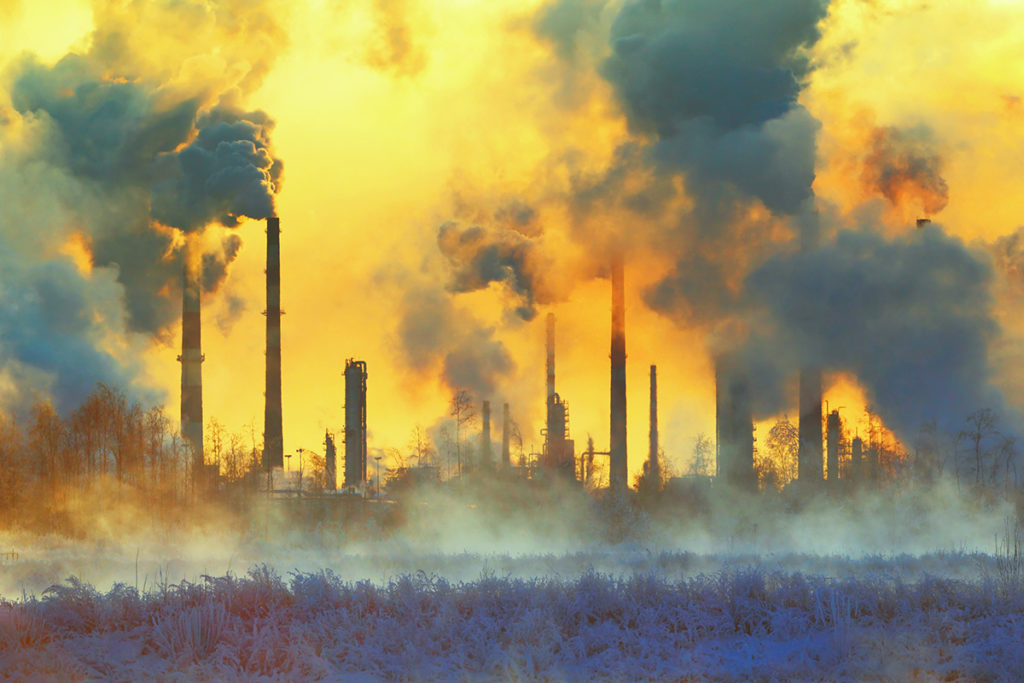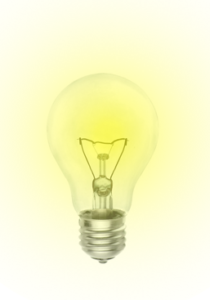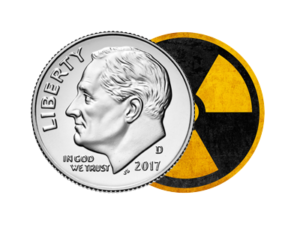
(you can see a newer version of this article here: The environmental impact of coal: CO2, pollution, land, and water.)
It’s hard to visualize millions of tons of anything so let’s reduce the question to something simple and personal. How much CO2 and various types of pollution would be released from a coal plant if we powered a 100-watt lightbulb for a year? Let’s dig in.
 Our lightbulb will need 876 kilowatt hours of electricity for its year of operations. Assuming an average power plant efficiency of 37%, our lightbulb will require 800 pounds of coal (see: How much coal does it take to power a 100-watt lightbulb?).
Our lightbulb will need 876 kilowatt hours of electricity for its year of operations. Assuming an average power plant efficiency of 37%, our lightbulb will require 800 pounds of coal (see: How much coal does it take to power a 100-watt lightbulb?).
So, for this hot tub sized pile of coal, what kind of unpleasant byproducts can we expect? Here’s a quick synopsis:
- 3 pounds of sulfur dioxide
- 1.67 pounds of nitrogen oxides
- 122 pounds of coal ash
- 0.64 ounces of uranium and thorium
- 1,680 pounds of carbon dioxide (how can that be?)
- 1/66th drop of mercury (nasty stuff)
For those of you that like to see the math or understand how more CO2 is created than the original weight of coal, you can follow along below.
3 pounds of sulfur dioxide pollution is emitted
Let’s start with sulfur dioxide (SO2), one of the main causes of acid rain. According to the EIA, the electric utility industry burned 851 million tons of coal in 2014. That same year, according to the EPA, the same utilities emitted about 3,195,000 tons of sulfur dioxide into the atmosphere. In other words, for every ton of coal burned, 0.00375 tons of SO2 is created.
3,195,000 tons of SO2 ÷ 851 million tons of coal = 0.00375 tons of SO2 per ton of coal 2000 pounds per ton × 0.00375 tons of SO2 per ton of coal = 7.5 pounds of SO2 0.4 tons of coal for our lightbulb × 7.5 pounds of SO2 per ton of coal = 3 pounds of SO2
By the way, coal-powered electricity is the largest source of SO2 by far, generating 64% of it in 2014.
1.67 pounds of nitrogen oxides are created
What about nitrogen oxides (NOx)? These pollutants create acid rain and smog. The same EPA report says that 1,776,000 tons of NOx were created by coal and the electric utilities. Applying the same math, our lightbulb will generate 1.67 pounds of nitrogen oxides.
GET MONTHLY NEWS & ANALYSIS
Unsubscribe anytime. We will never sell your email or spam you.
122 pounds of coal ash is left over
Coal ash is the solid byproduct left over after coal is burned. It is second only to trash as the largest source of waste material in the US. According to the EPA and the American Coal Ash Association, coal power plants created just under 130 million tons of ash in 2014. This means that every ton of coal we burn leaves 122 pounds of coal ash. Coal ash contains trace amounts of various toxic materials including chromium, arsenic, chlorine, chromium, lead, as well as uranium and thorium.
129,684,142 tons of coal ash in 2014 ÷ 851,000,000 tons of coal burned in 2014 = 0.1523902961 tons of ash per ton of coal burned 0.1523902961 pounds of ash per pound of coal burned (same ratio) × 800 pounds of coal to power a 100 watt lightbulb for a year = 121.91223688 pounds of ash created
In the US, most coal ash is captured and is no longer released into the air. Instead, it is often mixed with water and kept in nearby slurry ponds.
0.064 ounces of radioactive uranium and thorium
The geologic processes that create coal concentrate a range of trace materials into these black rocks. A study by the US Geologic Survey of 2,300 coal sites found the majority had concentrations of uranium between 1 and 4 parts per million. Similar results were found for thorium. Averaging this to 2.5 ppm for both elements leaves us with 5 ppm of radioactive materials per ton of coal.
 A concentration of 5ppm in a ton of coal means about 0.01 pound, or 0.16 ounces, or 4.5 grams of radioactive materials. Therefore, the 800 pounds of coal required to power our lightbulb will leave behind 0.064 ounces of uranium and thorium, a little less than the weight of a dime.
A concentration of 5ppm in a ton of coal means about 0.01 pound, or 0.16 ounces, or 4.5 grams of radioactive materials. Therefore, the 800 pounds of coal required to power our lightbulb will leave behind 0.064 ounces of uranium and thorium, a little less than the weight of a dime.
In some places, the concentrations can be 6-7 times higher – so high that at least one mining company is finding it cheaper to extract uranium from coal ash than uranium mines.
0.0000005 (same as 5 ppm) concentration of U and Th per ton of coal × 2,000 pounds per ton × 16 ounces per pound = 0.16 ounces of U and Th per ton of coal 0.16 ounces of U and Th per ton of coal x 800 lbs of coal to power lightbulb ÷ 2,000 lbs per ton = 0.064 ounces of U and Th in 800 pounds of coal
Just how dangerous is this radiation? Most research says not much at all. Remember, there is already a lot of natural background radiation and all the material from coal ash is caught and stored within the plant (at least in the US). So, even if you live within a mile of a coal plant, you will only increase your exposure to radiation about 5% a year, less than an x-ray.
More interesting is that nuclear plants have far less radiation. A widely cited paper by Alex Gabbard, of Oakridge National Laboratory, found that the radioactivity outside a coal plant is up to 100-times higher than a nuclear plant. This is largely due to the safety regulations governing the nuclear industry (see: What are the risks of radiation from nuclear power plants?)
1,670 pounds of carbon dioxide
Coal’s most notorious byproduct is carbon dioxide (CO2). Every million BTUs released from burning coal releases an average of 208 pounds of CO2 (see note below). Since a ton of coal has 20.025 million BTUs, that means it creates 4,172 pounds of CO2 when it is burned. Running our 100-watt bulb for one year will produce 1,670 pounds of CO2.
But wait, how can 800 pounds of coal produce twice its weight in CO2? Another article from the EIA explains this in detail but, in short, it’s because the carbon atoms in coal are each combined with two atoms of oxygen from the air to form the CO2. In other words, the extra weight comes from pulling in material for the air.
At room temperature and pressure, 1670 pounds of CO2 would fill three 18-wheeler trucks.

20.025 million BTUs per ton
× 208.364 pounds per million BTUs
= 4,172.4891 pounds of CO2 per ton of coal
= 1,668.99564 pounds of CO2 per 800 pounds of coal
Note: this math is based on weighted average data. The specific amount of CO2 released varies with the kind of coal. US plants burn 45% bituminous, 47% subbituminous, and 7% lignite coal (source: EIA). They release 205.7, 214.3, and 215.4 pounds of CO2 per BTU, respectively (source: EIA). The weighted average is 208.364.
1/66th drop of mercury
OK, this one will take some work but it’s important to do because some forms of mercury can be really nasty stuff. Coal plants account for half of all human-released mercury (source: EPA). Mercury is a heavy metal and a potent neurotoxicant. The type of mercury in thermometers carries some health risks but when it is released into the atmosphere, it combines with other elements and can easily create far more toxic variants.
There is a widely told story of a researcher, Karen Wetterhahn, who tragically died after only a drop or two of a particularly lethal compound of mercury fell on her hand. Despite wearing latex gloves, the mercury seeped through to her skin in a matter of seconds and she later died. This story is meant to be illustrative and drive home the health risks of mercury. It is not a scientific study or safety evaluation. But, if you want to look at the math and see how it works for yourself, read on…
An EPA report called The National Emissions Inventory (page 2-30) estimates that 22.9 tons of mercury were released from coal-fired power plants in 2014 (note that other environmental studies put this number 2-4 times higher). This means that 0.00000002809816 tons of mercury, or 0.00005619632 pounds of mercury, or 0.02549065075 grams of mercury comes from each ton of coal.
22.9 tons of mercury ÷ 851 million tons of coal = 0.00000002809816 tons of mercury per ton of coal 0.00000002809816 tons × 2000 pounds per ton = 0.00005619632 pounds of mercury per ton of coal 0.00005619632 pounds × 453.6 grams per pound = 0.02549065075 grams of mercury per ton of coal
Since pharmacists define 0.05 milliliters of liquid as a drop and 1 gram of mercury fills 0.073888 milliliters (mercury conversion), one ton of coal contains 0.03766906406 drops of mercury.
0.02549065075 grams of mercury per ton of coal
× 0.073888 milliliters per gram
= 0.001883453203 milliliters of mercury per ton of coal
0.001883453203 milliliters of mercury per ton of coal
÷ 0.05 milliliters per drop
= 0.03766906406 drops of mercury per ton of coal
Our lightbulb takes 800 pounds, or 0.4 tons of coal, which means burning it creates 0.01506762562 drops of mercury or rounding it a bit, 1/66th of a drop.
0.02549065075 drops of mercury per ton of coal
× 0.4 tons of coal to power a 100 watt lightbulb for a year
= 0.01506762562 drops of mercury per 100 watt lightbulb per year
1 ÷ 0.01506762562 drops = 66.36 or 1/66th
Additional Reading
- The US Energy Information Administration annual report on coal
- From the Freeing Energy Project: Five trends that will lead to the end of fossil fuels
Caveats
Note: There are numerous sources of information on the topic of coal byproducts. The math is shown here to help explain how our numbers were derived but it is inevitable that other approaches will yield different results. If you find a glaring mistake, please let us know in the comments below.
Also note: we use the US government data wherever possible. Many environmental groups do their own studies and find pollution is often worse than reported by the government. Our goal here is to bring as many people as possible into these conversations so we avoid using data that could be dismissed as aggressive.




22 Responses
Then, the solution is Nuclear Power!
You might be interested to read: http://www.freeingenergy.com/the-bottom-line-on-nuclear-power-high-costs-and-safety-concerns-darken-its-future-part-7/
You might want to add a paragraph on how much uranium is released when coal is burned. I read an article that claimed it was more significant than the amounts released by nuclear power plants.
Great suggestion! A section on nuclear has been added. There was very little reliable data to pull from but the final amount was higher than I expected.
on the other hand SO2 has actually cooling effect for Earth’s atmosphere, due to light reflection back in space (as well as hard particles)… so not that straight forward as well
CO2:is not a pollutant!!!!!
Agreed. The title has been changed.
Looking to the huge consumption of coal and continuously increasing trend power generation, it mast be made mandatory for government bodies to check the Radiation level at every ash pond regularly.
870kilowat only a light bulb?….FALSE!!!
We welcome your feedback on the math which is posted in a related article here: http://www.freeingenergy.com/how-much-coal-does-it-take-to-power-a-100-watt-lightbulb-for-a-year/
Low cost reliable renewable energy can reduces various pollutions regarding climate change.
Unlimited tidal wave energy can take a big role.
An idea (Page 97)
https://premc.org/doc/ICREN2019/ICREN2019_Book_Of_Abstracts.pdf
we need more natural CO2 scurber which is none other than TREES. We also have to estimate how much a single tree contributes in scurbing CO2.
It’s 870 Kilowatt-HOURS…. not 870 kilowatts. KWatt-Hours is a measure of energy. KWatts is a measure of power.
To go from Power to energy, you must multiply by time.
Bottom line: The article is correct, your comment is wrong.
How come the co2 emission level is doubled when burning coal? What is the scientific explanation?
The carbon in coal combines with the heavier oxygen from the air. It is explained briefly in the section of this article that talks about CO2 outputs.
The EPA figure for sulphur dioxide emission is for all power stations, not just coal. Furthermore, a lot of the sulphur is scrubbed from the flues, so only a small proportion of the sulphur from boring the coal ends up in the atmosphere. How can I find out how much sulfur is emitted from boring a ton of coal in a power station, before it is scrubbed?
Good question. I do believe the SO2 output varies with specific types of coal, bituminous, sub-bituminous, anthracite, etc. Thanks for your point about the source of the data on SO2. If you click on the top of this article, it will take you to a much more recent version of the article with a specific report on coal-based SO2. According to it, 98% of fossil fuel SO2 comes from coal.
My wife and I are retired and live in Ontario, where my wife was born. I emigrated here from the United Kingdom in the early sixties and remember the coal use their, with disdain and much sadness, at the amount of people it either killed or maimed, until Nuclear Power was installed, which changed everything for the better. Cleaner air, less breathing issues and no maimed children from coal effluent. Which we now call carbon. If the USA and others doesn’t soon start to build Nuclear plants to prevent the end of what we now call “
Mother Earth” then we Run the probable risk of destroying our beautiful planet of ours. The USA can call upon Canada, Britain and other experts to assist in building smaller Cold Nuclear reactors, that would be suitable for each state, in order to supply its own industries and citizens with its own power grids. Thereby solving the poisonous coal issue for ever, while helping to save our planet from a long slow death, along with every living thing on our beautiful blue planet. Then you would be helping our own Nuclear industry to help the entire planet to continue its destiny into a far safer future than we have right now. And that would make me very happy knowing that our grandchildren would get to enjoy this planet like we have done for the past eighty years.
Thank you for allowing me to express my concerns about our slow and ponderous movement towards building Nuclear Reactors in order to save our planet from self destruction, because of countries that just keep on burning coal, despite the very real dangers of doing so.
Thank you and keep on pushing this please as there is no other way out of the mess we have created for ourselves .
Sorry but these numbers are probably no longer valid with new coal burning power plants. Most of the by products listes are recovered and either recycled into other products or safely disposed of. I think about 98% or the Co2 is captured and not released. the 2% left will hardly keep a forest alive.
Thanks for sharing. I wasn’t aware any new coal plants were being built in the US or the EU. I’m fascinated to learn more. Can you share where these new generation of plants are being built and share some links to articles or papers that provide more detail on how the CO2 is being captured, and how these byproducts are being reused? As I’m sure you can tell from my article, we love to publish our data with lots of citations and sources. We will gladly update this article if you can provide data we have missed.
https://www.greenfacts.org/glossary/pqrs/supercritical-ultra-supercritical-technology.htm#:~:text=Supercritical%20%28SC%29%20and%20ultra-supercritical%20%28USC%29%20power%20plants%20operate,no%20difference%20between%20water%20gas%20and%20liquid%20water.
I think this is the technology to which David was referring. While I could find no evidence of attempts to “Reclaim” any byproducts, this newer technology being implemented overseas appears to operate at efficiencies as high as 45%. This would result in less coal burned per g/water. This higher efficiency would result in reduced emissions, cutting CO2 byproducts by approx, 25%. while merely a drop in the bucket, it is improvement.
Personally, I see the future being reliant on solar power, and power storage technologies. Solar panels are currently too expensive to be a complete solution, despite advances in the technology, and batteries capable of holding significant amounts of power are also unsustainable, due to both cost and scarcity of materials. Should solar be brought down to a cost effective point, then every government building, city owned office space, and public resource capable to carrying panels, should be carrying panels. Think about the last bridge you drove over. Did you look up? Probably not, but if you did, you didn’t see anything except bridge supports. What if those supports had solar cells on top of them, providing green power to the city?
I see a day when our power grids have the ability to catch and store lightning strikes. at 1,000,000,000 joules per strike, that is approximately 277kwh, with 0 emissions. Beyond us currently, but there is potential there.